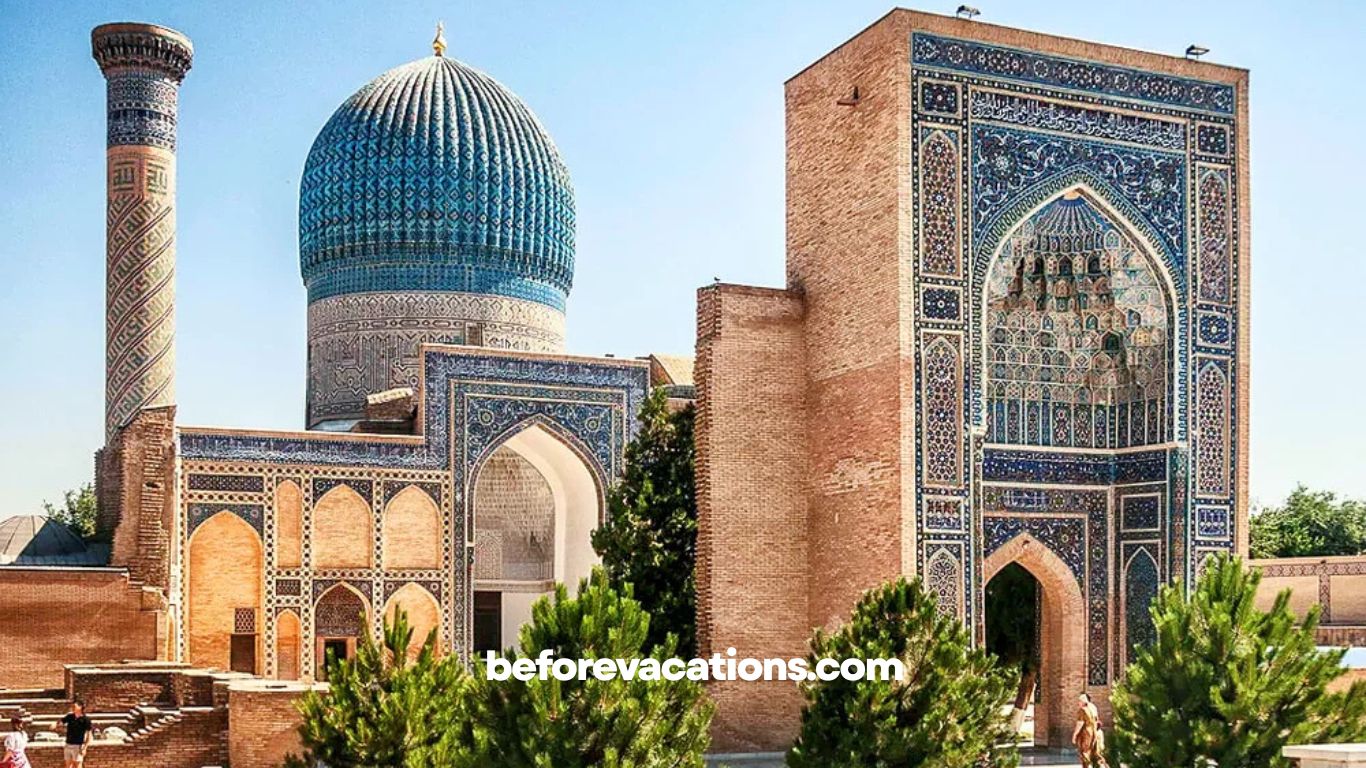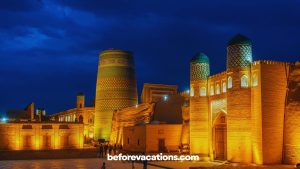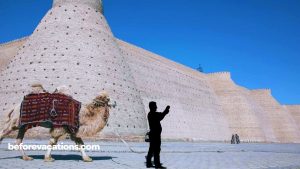Where the Heavens Bow: Why the Gur-e-Amir Mausoleum is Samarkand’s Spiritual Heart
The legendary city of Samarkand is a canvas painted in dazzling turquoise and gold. No single monument, however, embodies its imperial soul quite like the Gur-e-Amir Mausoleum. This site is more than a beautiful piece of architecture. It is the final, hallowed resting place of Amir Temur (Tamerlane). Temur was the formidable conqueror and founder of the vast Timurid Empire.
The striking, fluted azure dome crowns the structure. It has become an icon of Central Asian art. The dome inspired architectural styles. These styles later influenced masterpieces as far away as the Taj Mahal in India. For the global traveler, a visit here is not merely sightseeing. It is a solemn and awe-inspiring communion with one of history’s most powerful dynasties.
This comprehensive Gur-e-Amir Mausoleum Samarkand tour guide prepares you to step into the presence of history. It details its profound significance, stunning architecture, and the incredible legends that surround the “Tomb of the King.”
1. Historical Context: The Dynasty that Shaped a Continent
To truly appreciate Gur-e-Amir, travelers must first understand its powerful origins. The mausoleum, which translates from Persian as “Tomb of the King,” was never initially intended for Amir Temur himself. Its construction began around 1403, commissioned by a heartbroken Temur for his beloved grandson and designated heir, Muhammad Sultan, who died unexpectedly during a military campaign.
Temur had originally prepared a simple crypt for himself near his birthplace in Shakhrisabz. However, when Temur died unexpectedly in 1405 while planning an expedition to China, heavy snow had blocked the mountain passes leading back to Shakhrisabz. Therefore, his body was interred here, next to his grandson.
This unplanned burial instantly transformed the complex into the dynastic necropolis of the Timurids, significantly elevating its spiritual and political importance. The mausoleum ultimately became the resting place not only of Temur but also his sons, including Shah Rukh, and his brilliant grandson, the astronomer-king, Ulugbek.
The entire complex stands as a monumental testament to the artistic and intellectual peak of the Timurid era, showcasing a unified planning principle later replicated throughout the region.
2. Architectural Brilliance: Decoding the Iconic Azure Dome and Portal
The exterior of the Gur-e-Amir Mausoleum immediately captivates visitors with its elegant proportions and dazzling tilework. The building is an octahedral structure, or an eight-sided prism, mounted on a low drum. The tall, ribbed dome, famous for its deep azure color and fluted surface, rests atop a high cylindrical drum.
This use of a tall drum to elevate the dome’s height was a structural innovation of the Timurid era, instantly making the building stand out on the skyline.
Observe the detailed exterior walls, which are covered with geometric, floral, and epigraphic majolica and mosaic panels. These complex patterns showcase the mathematical precision and artistic finesse that characterized the Timurid period. The grandeur of the main entrance portal, or pishtaq, with its intricate muqarnas—the honeycomb-like stalactite vaulting—serves as a transition from the everyday world outside to the sacred space within.
Experts regard the aesthetics displayed here as the direct inspiration for later Mughal architecture in India, including the famed Taj Mahal and Humayun’s Tomb.
3. Inside the Sanctum: Gold, Onyx, and the Royal Cenotaphs
Stepping inside the main burial chamber of the Gur-e-Amir Mausoleum is a breathtaking experience. This experience contrasts the solemnity of a tomb with overwhelming artistic luxury. The interior walls are richly decorated with gilded kundal. Kundal is a raised gold-leaf technique. Artisans applied it to beautiful relief muqarnas and star-patterned murals. The lower part of the chamber’s walls features exquisitely polished onyx slabs. These slabs provide a dark, reflective base. This base accentuates the golden splendor above.
At the center of the chamber, surrounded by a low marble railing, sit the decorative tombstones, or cenotaphs, marking the graves of the Timurid dynasty. The most prominent is the simple, dark-green jade block placed over Amir Temur’s grave by Ulugbek.
The markers for his sons and grandsons surround him. This includes Ulugbek, whom someone tragically beheaded in 1449. Important Fact: As is common in Islamic mausoleums, these stones are markers. The actual sarcophagi containing the remains of the Timurid rulers lie in an identical arrangement in a quiet, concealed crypt located directly below the main chamber.
4. The Legend of the Curse: History Meets Myth at Timur’s Tomb
No visit to the Gur-e-Amir Mausoleum is complete without hearing the famous “Curse of Tamerlane,” a piece of local lore that dramatically intersects with 20th-century history. For centuries, an inscription on the tomb guarded the conqueror’s rest. This inscription is sometimes translated as, “Whoever opens my peace in this life or the next will be subjected to suffering and die.”
In June 1941, Soviet anthropologist Mikhail Gerasimov and his team opened the crypt to study the remains of Temur and his family. Famously, just two days later, on June 22, 1941, Nazi Germany launched a massive surprise invasion of the Soviet Union. This major historical event cemented the local legend of the curse.
Following heavy losses in the war, Joseph Stalin reportedly ordered Temur’s remains to be reburied with full Islamic rites. The reburial took place in November 1942, and many locals credit the subsequent Soviet victory in the Battle of Stalingrad just a few months later as the lifting of the curse. Scientific investigation confirmed that Temur was tall and indeed had a lame leg, just as historical accounts suggested.
5. Practical Visitor Information and Nearby Highlights
The Gur-e-Amir Mausoleum is located a short taxi ride or a pleasant 20-minute walk south of Samarkand’s iconic Registan Square. It is generally open daily from 8:00 AM to 7:00 PM, though travelers should verify the exact hours upon arrival. Foreign visitor entrance fees typically hover around 75,000 UZS (approximately $6-7 USD).
Consider hiring an official local guide at the entrance. They can expertly narrate the stories of the Timurids. They also point out architectural details and hidden inscriptions. These details enrich the experience far beyond what guidebooks write.
Before leaving the complex, take a moment to walk through the surrounding park. You can see the nearby Rukhobod Mausoleum, one of Samarkand’s oldest surviving monuments. More importantly, plan your visit to ensure you return after dark. The sophisticated spotlights illuminating the mausoleum transform the turquoise dome into a magical, glowing beacon against the night sky, offering a photographic opportunity you won’t want to miss.
Start Exploring: Ready to stand before the tomb of the legendary Tamerlane? Book a sunset visit to Gur-e-Amir and witness the golden architecture shimmer under the evening lights.











